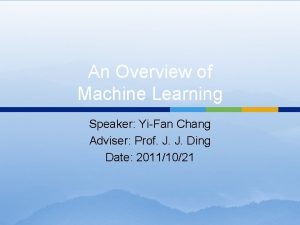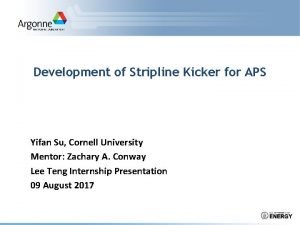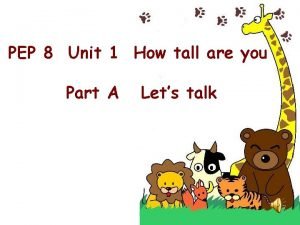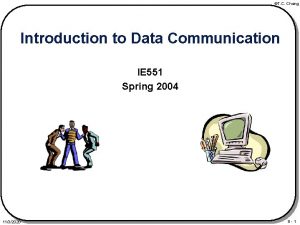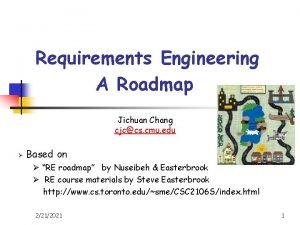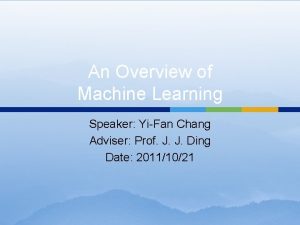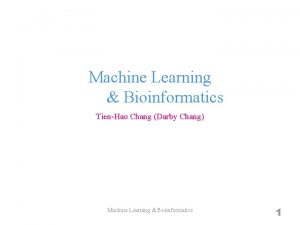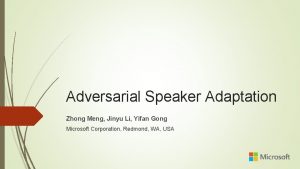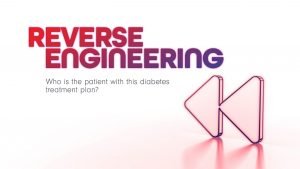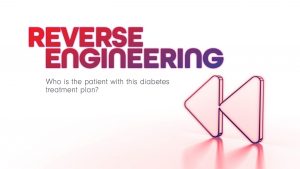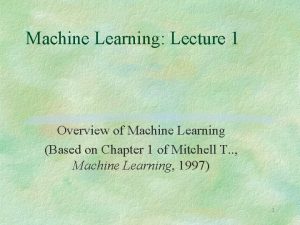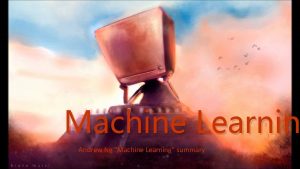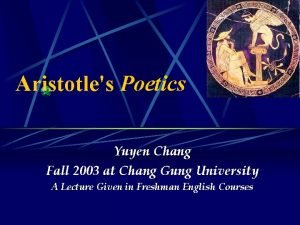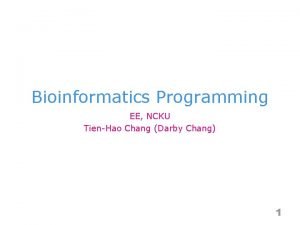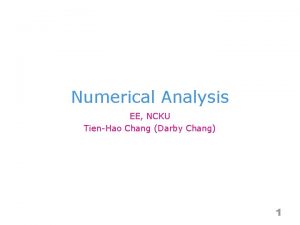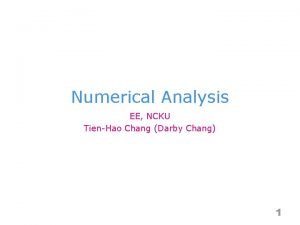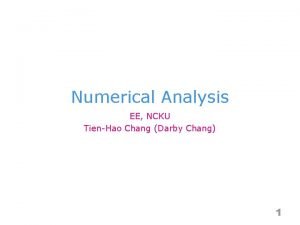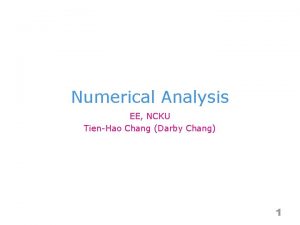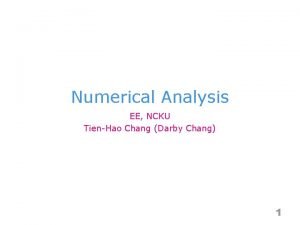An Overview of Machine Learning Speaker YiFan Chang






















![Reference [1] W. L. Chao, J. Ding, “Integrated Machine Learning Algorithms for Human Age Reference [1] W. L. Chao, J. Ding, “Integrated Machine Learning Algorithms for Human Age](https://slidetodoc.com/presentation_image_h/9b161cf562e2dd232625541c5c616d1b/image-23.jpg)
- Slides: 23

An Overview of Machine Learning Speaker: Yi-Fan Chang Adviser: Prof. J. J. Ding Date: 2011/10/21

Outline & Content What is machine learning? ¥ Learning system model ¥ Training and testing ¥ Performance ¥ Algorithms ¥ Machine learning structure ¥ What are we seeking? ¥ Learning techniques ¥ Applications ¥ Conclusion ¥

What is machine learning? ¥ A branch of artificial intelligence, concerned with the design and development of algorithms that allow computers to evolve behaviors based on empirical data. ¥ As intelligence requires knowledge, it is necessary for the computers to acquire knowledge.

Learning system model Testing Input Sample s Learnin g Method Syste m Training

Training and testing Data acquisition Practical usage Universal set (unobserve d) Training set (observed) Testing set (unobserve d)

Training and testing ¥ Training is the process of making the system able to learn. ¥ No free lunch rule: ¥ ¥ Training set and testing set come from the same distribution Need to make some assumptions or bias

Performance ¥ There are several factors affecting the performance: ¥ ¥ ¥ Types of training provided The form and extent of any initial background knowledge The type of feedback provided The learning algorithms used Two important factors: ¥ ¥ Modeling Optimization

Algorithms ¥ The success of machine learning system also depends on the algorithms. ¥ The algorithms control the search to find and build the knowledge structures. ¥ The learning algorithms should extract useful information from training examples.

Algorithms ¥ Supervised learning ( ) ¥ ¥ ¥ Unsupervised learning ( ) ¥ ¥ ¥ Prediction Classification (discrete labels), Regression (real values) Clustering Probability distribution estimation Finding association (in features) Dimension reduction Semi-supervised learning Reinforcement learning ¥ Decision making (robot, chess machine)

Algorithms Unsupervised learning Supervised learning 10 Semi-supervised

Machine learning structure ¥ Supervised learning

Machine learning structure ¥ Unsupervised learning

What are we seeking? ¥ Supervised: Low E-out or maximize probabilistic terms E-in: for training set E-out: for testing set ¥ Unsupervised: Minimum quantization error, Minimum distance, MAP, MLE(maximum likelihood estimation)

What are we seeking? Under-fitting VS. Over-fitting (fixed N) error (model = hypothesis + loss functions)

Learning techniques ¥ Supervised learning categories and techniques ¥ ¥ ¥ Linear classifier (numerical functions) Parametric (Probabilistic functions) ¥ Naïve Bayes, Gaussian discriminant analysis (GDA), Hidden Markov models (HMM), Probabilistic graphical models Non-parametric (Instance-based functions) ¥ K-nearest neighbors, Kernel regression, Kernel density estimation, Local regression Non-metric (Symbolic functions) ¥ Classification and regression tree (CART), decision tree Aggregation ¥ Bagging (bootstrap + aggregation), Adaboost, Random forest

Learning techniques • Linear classifier , where w is an d-dim vector (learned) ¥ Techniques: ¥ ¥ ¥ Perceptron Logistic regression Support vector machine (SVM) Ada-line Multi-layer perceptron (MLP)

Learning techniques Using perceptron learning algorithm(PLA) Trainin g Error rate: 0. 10 Testing Error rate: 0. 156

Learning techniques Using logistic regression Trainin g Error rate: 0. 11 Testing Error rate: 0. 145

Learning techniques • Non-linear case ¥ Support vector machine (SVM): ¥ Linear to nonlinear: Feature transform and kernel function

Learning techniques ¥ Unsupervised learning categories and techniques ¥ ¥ ¥ Clustering ¥ K-means clustering ¥ Spectral clustering Density Estimation ¥ Gaussian mixture model (GMM) ¥ Graphical models Dimensionality reduction ¥ Principal component analysis (PCA) ¥ Factor analysis

Applications ¥ Face detection ¥ Object detection and recognition ¥ Image segmentation ¥ Multimedia event detection ¥ Economical and commercial usage

Conclusion We have a simple overview of some techniques and algorithms in machine learning. Furthermore, there are more and more techniques apply machine learning as a solution. In the future, machine learning will play an important role in our daily life.
![Reference 1 W L Chao J Ding Integrated Machine Learning Algorithms for Human Age Reference [1] W. L. Chao, J. Ding, “Integrated Machine Learning Algorithms for Human Age](https://slidetodoc.com/presentation_image_h/9b161cf562e2dd232625541c5c616d1b/image-23.jpg)
Reference [1] W. L. Chao, J. Ding, “Integrated Machine Learning Algorithms for Human Age Estimation”, NTU, 2011.
 Conclusion machine learning
Conclusion machine learning Guess
Guess Yifan su
Yifan su How tall is pep
How tall is pep Concept learning task in machine learning
Concept learning task in machine learning Analytical learning in machine learning
Analytical learning in machine learning Pac learning model in machine learning
Pac learning model in machine learning Pac learning model in machine learning
Pac learning model in machine learning Inductive and analytical learning in machine learning
Inductive and analytical learning in machine learning Inductive vs analytical learning
Inductive vs analytical learning Instance based learning in machine learning
Instance based learning in machine learning Inductive learning machine learning
Inductive learning machine learning First order rule learning in machine learning
First order rule learning in machine learning Remarks on lazy and eager learning
Remarks on lazy and eager learning Deep learning vs machine learning
Deep learning vs machine learning Cuadro comparativo e-learning b-learning m-learning
Cuadro comparativo e-learning b-learning m-learning Early years learning framework overview
Early years learning framework overview Finite state machine vending machine example
Finite state machine vending machine example Mealy and moore sequential circuits
Mealy and moore sequential circuits Moore machine to mealy machine
Moore machine to mealy machine Ma=fr/fe
Ma=fr/fe Joe chang
Joe chang Tc chang
Tc chang Requirements engineering a roadmap
Requirements engineering a roadmap
